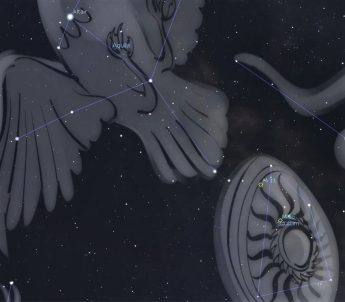This Week’s Sky at a Glance, 2024 June 29 – July 6
This Week’s Sky at a Glance, 2024 June 29 – July 6
Sagittarius is an old constellation of a centaur with a bow and arrow aiming toward Scorpius the Scorpion. If he tries to shoot Aquila the Eagle above, chances are the arrow will be deflected by a shield.
Scutum the Shield is a relatively new constellation, created by the Polish astronomer Johannes Hevelius in the late 17th century. It commemorates the Polish king John Sobieski III, who defended his country against the Turks. Originally named Scutum Sobiescianum (Sobieski’s Shield) it is generally just called the Shield. Seeing it can be difficult, for its main stars are dim and shielded within the Milky Way. One way to locate it is to find its most prominent deep sky object, the Wild Duck Cluster or M11.
Find the bright star Altair in the head of Aquila and then identify the wings and tail of the eagle. Binoculars will reveal a string of stars leading from the tail to M11 at the top of the shield. The rich Wild Duck Cluster looks good in binoculars and great in a scope, and an imaginative observer can see a V-shape or maybe two. Star cluster M26 is also in Scutum, a binocular width south of M11.
This Week in the Solar System
Saturday’s sunrise is at 5:39 and sunset will occur at 9:15, giving 15 hours, 36 minutes of daylight. Next Saturday the Sun will rise at 5:43 and set at 9:13, giving 15 hours, 30 minutes of daylight. Earth is at aphelion, its farthest from the Sun, on July 5, but don’t expect a snowfall.
The Moon is near Mars on Monday morning, near Uranus Tuesday and Jupiter on Wednesday. The New Moon occurs Friday, and a slim crescent will be near Venus next Saturday after sunset. Saturn is at its first stationary point on Sunday, beginning four and a half months of retrograde motion against the stars of Aquarius. Mars is well-placed for early morning observing in the east, leading Jupiter by an hour. Mercury and brighter Venus can be picked out of evening twilight with binoculars, with Venus setting 30 minutes after sunset this weekend and Mercury about 40 minutes after that. I saw both on June 25.
On Sunday evening at 8 pm, celebrate Asteroid Day by tuning in to the Sunday Night Astronomy Show via the Facebook page or YouTube channel of Astronomy by the Bay. The Saint John Astronomy Club meets in the Rockwood Park Interpretation Centre on July 6 at 7 pm.

